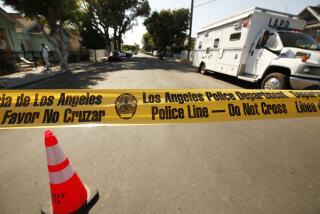Plot Possibly Went Beyond N.Y. Tunnels
- Share via
WASHINGTON — The alleged mastermind of a plot to bomb train tunnels connecting New York City and New Jersey also discussed blowing up subway cars in Manhattan, and even toyed with the idea of setting a wildfire in California, U.S. counter-terrorism officials said Sunday.
U.S. and Lebanese officials said they learned of discussions between Assem Hammoud and a number of co-conspirators by monitoring their e-mail traffic on a website used by Islamic militants, and by scouring Hammoud’s computer and his Beirut home and office after his arrest April 27.
Such discussions, U.S. authorities said, suggested that Hammoud and as many as seven other accomplices were still searching for ways to strike the United States when the plot was disrupted.
Two U.S. intelligence officials said that so far, no evidence indicated that the alleged co-conspirators were about to enter an operational phase -- as some U.S. and Lebanese authorities have said in recent days -- or that they had even decided to go forward with the plot.
“There have been suggestions that this was a lot further along than it was,” said one of the U.S. officials.
“The bottom line is that there may have been less here than meets the eye.”
Hammoud, 31, has been charged in Lebanon with being mastermind of the plot. Authorities there say he has confessed to that and to pledging an oath of allegiance to Al Qaeda.
Two other men are being held in undisclosed locations overseas, and authorities have linked five others to the alleged plot.
The U.S. intelligence official said that authorities in the United States, Lebanon, Denmark and other countries were trying to unravel threads of the alleged plot that could give them a clearer picture of the suspected terrorists’ intentions.
He said U.S. authorities were trying to reconcile their intelligence with claims by Lebanese authorities that Hammoud had connections to Al Qaeda and was intent on launching an attack.
But, the official cautioned, “there is good reason to be skeptical about how far along this had gone....
“It was in large part jihadist bravado.”
The second intelligence official said, “They had no logistical arrangements; they certainly hadn’t done the kind of thorough intelligence check; they didn’t have explosives.” The official added that comments about an Al Qaeda connection to the plot appeared to be somewhat overblown.
“These were people who had associations with people who had associations with potential [terrorist] networks. You’re talking a couple steps removed,” the official said.
These officials and other U.S. authorities interviewed Sunday spoke on condition of anonymity, citing the ongoing investigation and the sensitivity of working with foreign intelligence services on three continents.
One federal law enforcement official confirmed, but also downplayed, Hammoud’s alleged discussions about setting a wildfire in California.
That official said that Hammoud had visited relatives near San Francisco in 2000 but that authorities had found no connections between the visit and any alleged terrorist activity or planning.
He described the wildfire discussions as “chitchat” in an Internet chat room frequented by jihadists who often made hyperbolic statements.
The law enforcement official also said that though the communications of the alleged plotters indicated they were focusing on detonating suicide bombs in the tunnels below the Hudson River, they had also discussed setting off backpack bombs or other explosives on New York subways.
Over the weekend, Lebanese authorities released more information on the case, some of which appeared to contradict the speculation by the U.S. intelligence officials.
Acting Interior Minister Ahmed Fatfat said Sunday that Lebanese authorities had found “very important” incriminating evidence on Hammoud’s personal computer, including maps and “bombing plans that were being prepared.” Fatfat’s comments, made during a TV interview in Beirut, were reported by the Associated Press.
“This information helped the investigators make Hammoud confess to his role in plotting a terror act in America,” one official told the AP, speaking on condition of anonymity.
A statement by the general directorate of Lebanon’s Internal Security Forces said Hammoud, also known as Amir Andalousli, appeared to be “living a life of pleasure, far from suspicions,” before his arrest.
But the Lebanese security force said Hammoud sent detailed maps about possible terrorist targets to his “partners” through the Internet, and was intending to travel to Pakistan to undergo four months of weapons training before launching the attack at the end of 2006.
It also said that Hammoud accompanied an unidentified Syrian man to the notorious Ain Helweh refugee camp in Lebanon in 2005 for light-weapons training, and that he met “a foreigner, who asked him to guarantee apartments to host jihadists, recruit persons, and collect money and weapons for the organization.”
The government statement was translated into English by Arabic scholar Walid Phares, a senior fellow at the Foundation for the Defense of Democracies, and posted online at the Counterterrorism Blog.
Peter Bergen, a terrorism expert, said it was not unusual to have contradictory information about a suspect, especially when a plot was broken up by authorities before it was executed.
“They were discussing this plan. Was it a really big deal? You know, I don’t think so,” Bergen said Sunday on CNN’s “Late Edition.” “But was it worth stopping it? Of course.”
More to Read
Sign up for Essential California
The most important California stories and recommendations in your inbox every morning.
You may occasionally receive promotional content from the Los Angeles Times.










